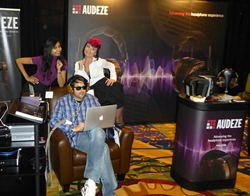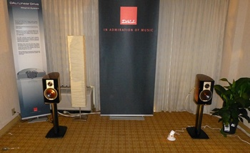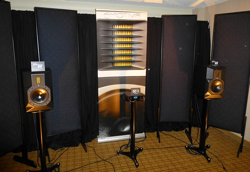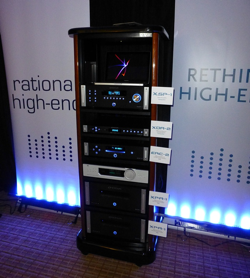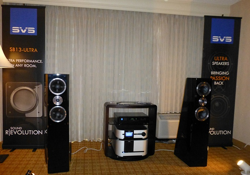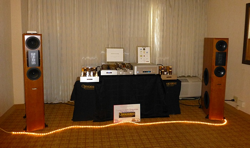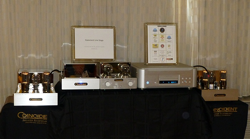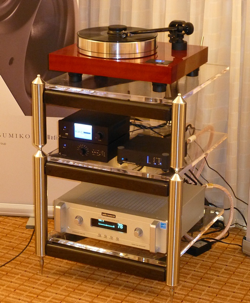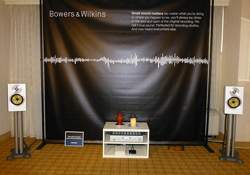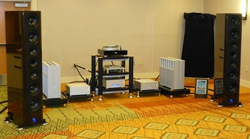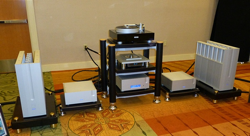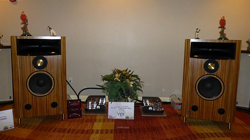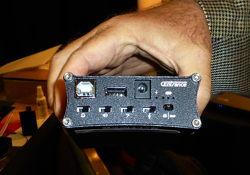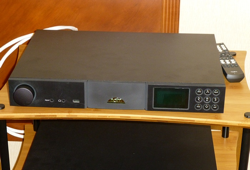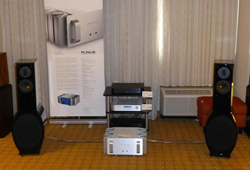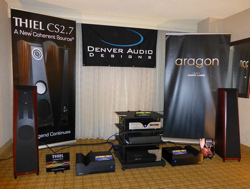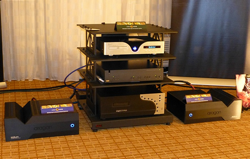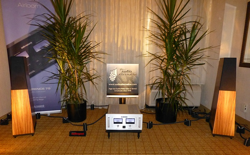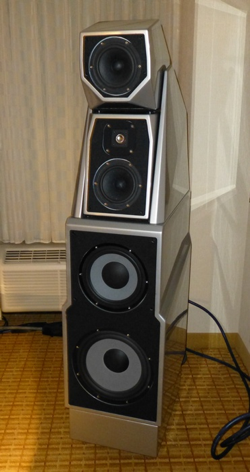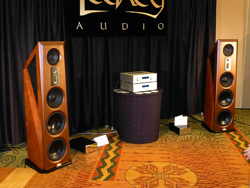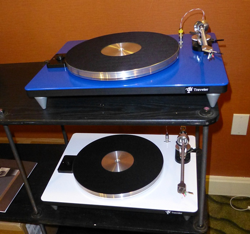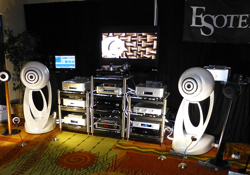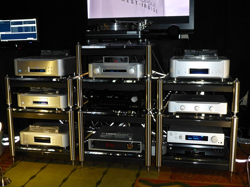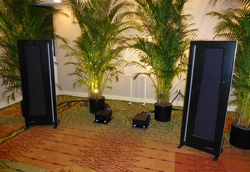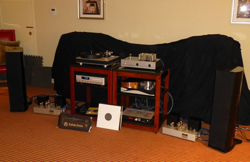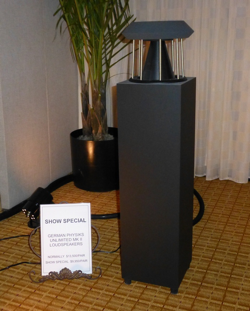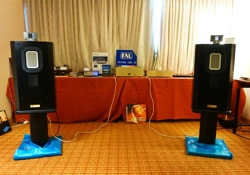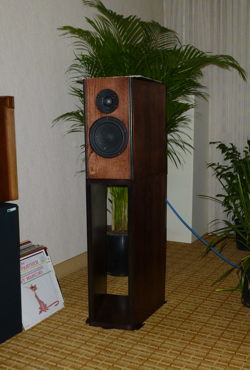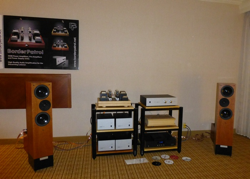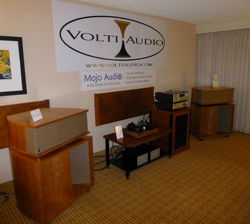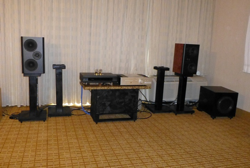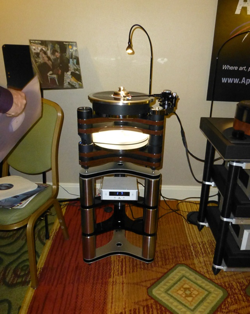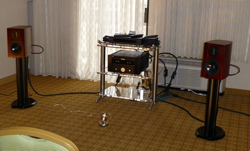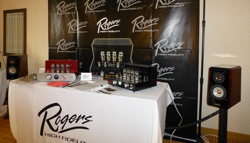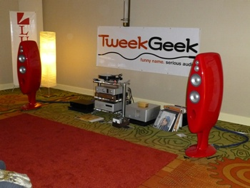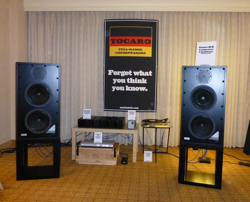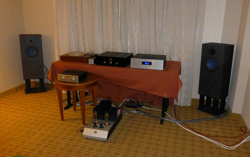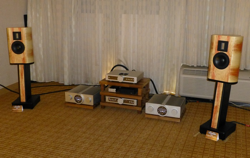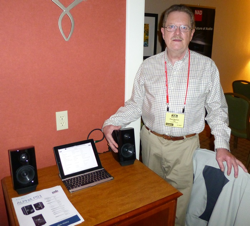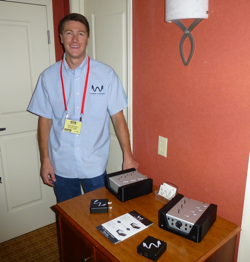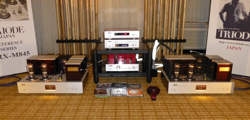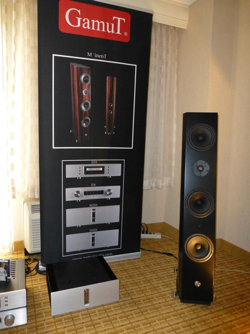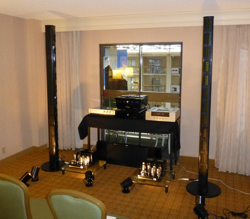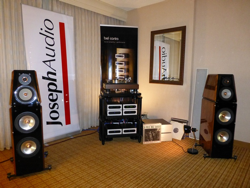The 2012 installment of RMAF was bigger and better than ever before. There were even more exhibitors and attendees than last year. Plus, there was a good vibe among everybody at the show. There was a pervasively positive and upbeat feeling flowing throughout the whole event.
I would also like to echo the sentiments of several of the people I spoke with: RMAF is one of the better shows around. This goes not only for the venue, but it also involves the quality of products on hand in addition to the way the event is staged and managed. Naturally, this all starts with the tireless efforts and the accommodating nature of the good folks from the Colorado Audio Society. I give them two thumbs up on a show well done!
As far as source components are concerned, I noticed more turntables were actually in use this year. About a third of the rooms I visited were spinning vinyl when I came in. The remaining rooms were predominantly running digital but I did have a chance to listen to a couple of reel to reel decks as well. Sweet.
This show has something for everybody, from DIY projects and earbuds all the way up to cost no object dream systems. And just like a car show, it is very revealing to compare products in a practically side to side manner as is possible at RMAF. Although we all strive for perfection in the reproduction chain the fact of the matter is that perfection is an unattainable goal. So each system has its own personality. Which one is right for you?
My advice? Any audiophile interested in purchasing new gear should attend a show like RMAF. It offers you a great opportunity to evaluate a sizable cross section of the best equipment out there so you can make the most informed decision as to what fits your lifestyle, budget, belief system and personality.
Also in the Sound Organisation room was this lovely pair of Epicon 2 stand mounted monitors ($8,000/pr with stands). The main driver is a unique wood fiber cone that is made in house and it is stimulated with Dali’s new Linear Drive Magnet System. The stands are a bit on the low side, so the speakers would need to be raked back in a typical set up. The Dali products are so very stylish in their look, build, operation and performance. I’d like to get these in for review, too so I could evaluate them in my own system and room.
Emotiva Pro was on hand at the show with their affordable line of powered studio monitors with folded-ribbon tweeters. Seen here are the new Airmotiv Stealth 8’s ($1,499/pr). They are bi-amped as with the other Emotiva Pro monitors.
Emotiva Pro also had a working prototype of their new DAC, the DC-1. It should retail at around $700 when it comes out. It is a 24/192 USB asynchronous switchable DAC. It was processing a signal that was streaming off a MacBook. The sound was at once vibrant, full-bodied and with a knack for proper instrument placement.
Emotiva was in the next room with two new products. The first was the XSP-1 Differential Reference Preamplifier ($899) which is just now available. The other new product was the XDA-2 Differential Reference USB DAC/Preamp which should be available soon. Their slogan is “Rational High End”. They played Evita for me. Female vocals are good test for Hi Fi systems and Emotiva got a solid “A” on this day.
Here is the SVS room where they were showing off their new SVS Ultra Towers ($1,999/pr). It was a wise choice on their part to bring in Classe amplification. The Diana Krall track we auditioned impressed me quite a bit, particularly when you consider the price point of these speakers. Designed by Mark Mason, the Ultra Towers were optimized using FEA methods and feature dual opposing 8-inch woofers.
SVS also had this new model on hand, the SB-13 Ultra sub ($1,599). It has an all-new 13″ driver with a Rohacell composite cone, power courtesy of a 1,000W (3,200 watts peak power) DSP Sledge™ amplifier with sophisticated DSPs matched to the driver and cabinet and an equalization curve optimized for enhanced transient response. I think I would like to get one or two of these in for a review.
This is a system by Coincident Technology. New this year were the 70 wpc Dragon Mk II 211 PP Monoblocks ($10,999/pr) and the Total Victory V Speakers ($14,999/pr). The speakers have a ribbon tweeter, D’appolito 7″ composite mids and dual 12″ aluminum woofers (94 dB and 14 ohms). Also in play was their Statement Linestage ($5,499). I listened to a track with acoustic instruments and the strings simply jumped out of the speakers.
A closeup of the Coincident rack.
Aperion was demonstrating their new ARIS Wireless Speaker for Windows ($499). It is claimed to have 100w total power with bass down to 65 Hz.
The system in the Sony and Pass Labs room proved to me once again that Pass amplification exists among the elite group of highest-end electronics on the planet today. The little Sony floorstanders held up their end remarkably well. Sony would offer no details on the speakers as they were a prototype of a model that won’t launch until January. You can see they have two super tweeters in what looks like a D’appolito array with the primary tweeter. Interesting.
Sumiko had their own room at RMAF this year. The speakers here were the Sonus Faber Model Venere 1.5 ($1,195/pr, stands $398). The amplification was courtesy the Audio Research Model DSi200 200 wpc Integrated ($5,995). The digital source was the Wadia Model 121 DAC ($1,299) with the Pro Ject Model Stream Box RS ($1,999). The analog components were the Pro Ject Xtension 10 table bundled with the Blackbird Cartridge ($3,699) and the Pro Ject Phono Box ($999). This system is further proof that Sumiko is your on-stop source for high quality gear throughout the reproduction chain.
Take a gander at the lovely Pro Ject Xtension 10 turntable. Look for a review of this table on the Secrets main site by yours truly in a few months. I have one in my system spinning a record right at this moment. It is a fine piece of engineering and craftsmanship for an almost unheard of price.
A bunch of people were hovering around the Magnepan room to get in on their demo. The folks from Magnepan had the good sense to schedule demos and keep the door closed. I was late and was forced to sit in the back row. The demo involved a “3-channel stereo” system with their new MMG’s plus bass panel ($1,394) with a no-risk home trial. Nice sounds, made in America. I’m not sure how they do it either.
The B&W CM 5 speakers ($1,500/pr) and the Rotel RA-12 ($800) 60 wpc digital integrated were playing an alac encoded file of Mighty Sam McClain “When the Hurt is Over”. This is an excellent, affordable everyman system that would satisfy a vast majority of audiophiles, showing once again why B&W and Rotel are market leaders in their respective product categories. This would be a good starting point for folks with normal sized living spaces who want a system that’s easy to set up. I was impressed.
This is Tony Weber, Regional Sales Manager at Cary Audio. He was showing a new, affordable Cary product line that will be sold under the Audio Electronics name. The lineup includes the Constellation Preamp, the Hercules Power Amp, the Lightning DAC and the Nighthawk Solid State Headphone amp. This will be a very interesting product line from a respected manufacturer that begs to be to explored.
Brian Ackerman of Aaudio Imports always has a stellar array of high end equipment to show off at RMAF and this year was no exception. Seen here is a big system built around Ypsilon electronics and Lansche speakers. The lineup started with the Bergman Sleipner Air Bearing Turntable and Tonearm ($54,000) with its bearingless floating platter and vacuum hold down, the Lansche No. 7 speakers ($108,000) with their unique plasma tweeters, the Ypsilon SET100 monoblocks ($125,000), the Ypsilon PST-100 MkII tube preamp ($37,000), the Ypsilon CDT-100 transport ($26,000), Ypsilon Valve DAC and Valve Phono Stage. Cables were by Tandem.
Here is the rack in the Aaudio Imports suite. I listened to some jazz quartet on this system. Sure this system is pricey, but it really brings you about as close as you can get to a real live performance experience. The overall presentation never brought on one single ounce of the subliminal agitation I sometimes feel with poorly done digital.
This system by Audio Limits was another uber high-end set up. The big and beautiful speakers were the Venture Ultimate References ($135,000). These speakers have 2″ Abaca Graphite Pulp Composite tweeters that are rumored to be capable of full-range response. The speaker is a true 3-way design with first order crossovers, one 7″ mid and 4~9″ woofers. 20Hz – 60kHz, 96 dB and 6 Ohm.
This is the $15,00 XXR Harmonic Resolution Rack holding the Weiss Man301 Music Archive Network Player ($12,262 with DAC), the Weiss Jason Transport ($22,707) and the FM Acoustics 245 Preamp ($25,800). Amplification was via a pair of FM Acoustics 115 Monoblocks (275 wpc) ($108,200). This system was so good it almost made a coherent sound out of a ragged, compressed cut from the summer of love – “White Bird” by It’s a Beautiful Day. It took me way back.
This big room had a pair of new Atmasphere Class A Triode OTL monoblocks ($12,000/pr) driving the Classic Audio speakers ($59,500/pr). The speakers have field coil drivers. Of course they were spinning big band when I came in the room. I can’t get enough of these throwback systems. The pacing with this system put a bounce in my step and brightened up my day. The background was silent too, a bit more than I expected with highly sensitive speakers like these.
Over at CanJam, I had to check in on the newest CEntrance DAC/headphone amp. They’ve dubbed this little beauty the HiFi-M8 ($699). It has a Lithium-Polymer rechargeable battery and it accommodates 1/4 inch unbalanced or balanced headphones.
Around back, you can see that this flexible little unit has tone controls and adjustable output impedance. The Audeze headphones I used to audition this preamp/DAC were an open design so ambient noise leaked freely, but the HiFi-M8 impressed me with a grain-free sound and a top octave free from sizzle. They were also standouts regarding vocal reproduction. Woodwinds had that real raspy quality that draws me in to the experience.
Jeff Rowland had this system that was built around the Aeris DAC ($9,800), the Corus Preamp ($12,800) and the new 625 stereo power amp ($13,500). This amp is a Class A/B design with no global feedback. The speakers were the Avalon Acoustics Mixing Monitors. I can hear why the Jeff Rowland Design products have been so well received throughout their history. The are well made, beautiful and their audio qualities are above reproach in just about every category. They are a great choice for a sophisticated consumer.
The VTL room was jam packed when I got there. They were using Transparent cables as were so many other rooms. The speakers were the Wilson Alexia’s ($48,500). The system had too much prominence in the lower treble. I’m not sure if you could blame it on the room or the program material, but I’ve heard their amps sound better. They still showed a great deal of available headroom on a dynamic recording.
Nola had the KO’s at the show this year ($9,800/pr). They are the new speakers at the top of the Boxer line. The open baffle design is one of my personal favorites and these are built to a more domestic scale than some of their larger models. The KO’s really got the midrange right.
The Sound Organisation had two rooms at RMAF this year. In the first room I visited, they had the PMC twenty.21 speakers ($2,600-$2,800/pr depending on finish). The source was a Rega RP6. These PMC’s are basically studio monitors with a very nice finish. They were quite neutral as you would expect. They are for those of you who don’t want their music editorialized.
This is the Naim 172 preamplifier. It is Naim’s first streaming preamp. It retails for $3,195 with FM tuner or $2,895 without the tuner.
The system in the Plinius room included the Tiki Network Audio Player ($4,775) which is a 24/96 network DAC with a single RJ45 input. Next down from the top was the M8 remote control preamp ($5,150) and below that was the SA-103 125 wpc Class A stereo amp ($10,150). The speakers were the Eficion F250’s which are a 3-way design with a 10″ carbon fiber woofer, a 5″ carbon fiber mid and an AMT tweeter ($9,950). This system was serving up a refined sound for the connoisseur. Think of a Manhattan apartment and you’ll get a very good idea of what I mean. It is a breath of fresh air over some of the raucous sounding systems around the show. An interesting twist is that one can lease a pair of Eficion speakers. I don’t think I’ve ever heard of such a thing from a high end company before.
Aragon has been resurrected from the afterlife by Indy Audio Labs. Seen here are a pair of their Iridium 400W Monoblocks ($3,999/ea) driving the Thiel CS2.7’s ($9,900/pr).
This closer shot reveals the Aragon Soundstage SSP ($4,499) that is slated for a future release. This is one of the products that I am most interested to review when it comes to market.
Wisdom Audio had their L75 Sage Series Line Source speakers at the show.
These Vandersteen Quatros were making nice sounds being driven with the new Audio Research Reference 75 stereo amp.
Wilson, Doshi and Transparent Audio teamed up to bring you the system here. The Doshi Jhor 160 monoblocks ($28,995/pr) is rated at 160 wpc and can be ordered with various transformers to match the load presented by your speakers. I do want to point out that I saw Transparent cables in a lot of rooms.
A close up of the big Wilson Maxx Series 3. This system didn’t have any weaknesses that I could hear. Now I really wish that one of my long lost relatives from Nigeria really would write me into their will once and for all.
The Doshi monoblocks up close and personal.
Here are the Kef Blades. I entered the room to the sound of the Talking Heads. You don’t hear that every day, even at RMAF. Next up was some modern jazz. There was a super wide stage with lots of bass energy. The speakers seemed to be just loafing in the giant space. The speck on top of the right speaker was a nickel that didn’t budge even when the sound got hot and heavy. This was an impressive performance. Extra benefit – as a Longhorn fan, I loved the burnt orange finish even on a day when my team got walloped by OU. Anyway, I walked off wondering what more could one need?
Here is the McIntosh lineup that drove the Blades so ably.
Legacy and AVM were showing a system right next door. They were also in a very large space. The system here included the all new Legacy Aeris speakers (starting from $15,900). The AVM gear in play was the MA3.2 Monoblock amps ($6,710/pair), the Evolution PA5.2 Preamplifier ($4,900) and the CD5.2 CD Player ($4,790).
The Legacy Aeris speakers have dual powered 12″ subs (750 watt IcePower) and an included 24-bit DSP with balanced and unbalanced analog inputs and outputs, level control, and both SPDIF coaxial and USB inputs. Bass extension is down 16Hz. The dual Air Motion tweeter features a new 4″ ribbon complimented by a 1″ AMT ribbon super-tweeter. As with other Legacy speakers I’ve heard, the scale was believable with all manner of instruments. Live recordings had the right decay so you feel like you are sitting in on a live performance. AMT tweeters are showing up in lots of speakers these days, but Legacy seems to do it at least a little better than the competition.
A collection of new VPI Travelers ($1,299 in black add $100 for other colors).
Take a look at this killer system from Esoteric. The big Cabasse L’Ocean system comes complete with the large white 4-way coaxial speakers and a digital preamp for a cool $159,990. Source and amplification are extra. This system was playing flamenco guitar with a full backing ensemble. The system had excellent transient response, very coherent.
Here is the rack in the Esoteric/Wireworld room. The Esoteric transport, dac and amplification were driving the L’Ocean system described above.
Seen here are the Arion Audio HS-500 monoblocks ($5,995/pr) driving the Analysis Audio Omega full-range planar-ribbon speakers ($22,000/pr) with the optional external crossovers ($2,400).
The rest of the Arion Audio system – LS-200 dual mono tube hybrid pre ($2,995), VPI Classic IV table ($8,000) with a Soundsmith Straingage Cartridge ($14,999), Sonus Veritas Venice Phono stage ($19,995) and Modena Tube DAC ($11,995). They were playing a little Dire straits. The system had limited bass extension but with an uncannily clean sound everywhere else. There was a wide stage but the layering was a bit limited. I would play with positioning the speakers if I had a chance. Meanwhile, the amps had a good grip on what must be a challenging load, especially obvious on “MTV”. The EMM Labs SACD player ($25,000) was rock solid.
Daedalus Audio and Mod Wright were showing this system in one of the large first floor meeting rooms. The speakers were the Orpheus Reference ($38,500/pr) and a pair of BOW Subs ($2,290/ea). Allison Krauss was singing with none of the overly aggressive upper mids that can make her voice sound too aggressive on lesser systems. On The Beatles “Come Together” there was a nice groove throughout the audible band including mid and upper bass.
The Mod Wright electronics in the room were the KWA Single Ended amps ($8,495), the LS 36.5 DM pre ($9,995), the Elyse DAC (prototype) and a Mod Wright “Truth” Oppo 95 ($2,995). Interconnects and power cords were by WyWires.
Induction Dynamics was demonstrating the S1.8T’s ($11,040 – $13,028 depending on finish). This is another great speaker system from Induction Dynamics. They were spinning Oscar Peterson on vinyl and it was some the most realistic piano I’ve heard at the show (so far). These speakers have it all, the upright bass was pitch perfect while top octave was extended.
It is Sunday morning as I write this and the show goes on through 4:00 pm today. I will have a bunch more material to post before all is said and done. My last post from the 2012 RMAF will probably be up on the CAVE as late as Tuesday the 16th. So please check back again later this week. I’ll have even more bargains and cost no object products to tell you about.
MBL was showing two complete systems in a large corner suite. Pictured here is the larger “Reference Line Combination D” system. It comes with a 1621A CD transport, a 1611F DAC, a 6010D preamp, a pair of 9011 monoblocks and a pair of 101E MkII Radialstrahler loudspeakers. It can all be yours lock, stock and barrel for $259,700. Amazing air of course with an all around luxurious sound. It would be hard to overstate how impressive this system sounds.
This is the smaller MBL system. They call this one the “Corona Line Combination C”. It comes complete with a C31 CD player, a C11 preamp, a C21 stereo power amp and a pair of 120 Radialstrahler loudspeakers. This sytem is only $48,600 and, in my estimation, gets you at least 80% of the way to the bigger system.
This room included a system from deHavilland, Kubala-Sosna and Wilson Benesch. The principals – deHavilland Ultraverve preamp ($2,995), the deHavilland 50A 45 watt triode monoblocks ($10,800/pr), the Wilson Benesch Vector Speakers ($14,500/pr) and the Wilson Benesch 18″ subwoofer ($10,300). Cables and interconnects courtesy of Kubala-Sosna. It was hard for me to get a firm grasp on the sound of this system due to unfamiliar program material.
German Physiks was back at the show again this year with an updated speaker, the Unlimited Mk II ($13,500). These speakers’ strong suit would be imaging and soundstaging. I would personally like to hear a flatter response. Also the bass was too lean despite a claimed 28 Hz roll off. My perceptions could be due to room interactions or set up. Other show attendees told me that these speakers settled in later in the show and the sound was much better balanced than when I visited their room on Day 1.
The C.L.U.E. bookshelf speakers ($999/pr) were playing a Patricia Barber when I came in the room. The woofers were working hard and kicking out unexpected bass extension. The response was a little lean in mid bass, but the speakers filled out room nicely for a modest pair of bookshelfs.
Antelope Audio will soon be releasing the Rubicon AD/DA preamp (est $40,000) seen here. It was on static display at RMAF this year. Antelope is best known for their pro audio gear and they had a stack of pro components to emmulate the operation of the upcoming Rubicon. The demo involved a signal from a vinyl source run as straight analog vs being run through the AD/DA conversion to show limited loss on fidelity. The demo was pretty convincing.
Emerald physics was showing a complete system that you can pick up for $6,000. For your 6k, you will get a Peachtree DAC, Emerald amp and a pair of the the new Emerald CS2P speakers. The system had lush vocals and a big stage. They played Stevie Ray over this system at at near live levels. I doubt you would have very much fatigue with this system but don’t think the sound was reticent. The system also had almost no pereceptible dynamic compression.
Here is the back of the Emerald speakers so you can see their open baffle design.
Now for something completely different, flat drivers. The Tokyo firm, FAL Co., Ltd. was at RMAF demoing a pair of speakers based on their own flat drivers. Well, they like to play it loud. The speakers would benefit greatly with further refinement on the voicing side. But they did have good transient characteristics.
The late great Stevie Ray Vaughn was also in play at the Odyssey room. The lights were down low. Simply put, this was a very fine sounding system with ambiance to spare. The whole system (without a source) is only $5,900. For that you get the Kismet Reference Monitors, the Candella pre, the Stratos stereo amp and Gronneberg Quattro Cables.
A closeup of the Kismet Reference Monitor. All the Odyssey products are made in the USA.
Meet Gary Dews. This affable gentleman from the UK is the brains and the brawn behind Border Patrol, makers of several tubed pre amps and power amps. Now based out of Maryland, all Border Patrol amps come with outboard tube rectified choke input filters similar to the one seen in the above image. Gary claims that this design allows his single-ended amps to have better rsponse at the frequency extremes, more dynamics and lower THD when compared to tube amps from other companies.
Here is a wider view of the Border Patrol system. It includes an EXT1 triode line stage with a heavy duty dual transformer external PSU ($12,250), an S20 Power amp rated at 18 wpc with 300B output tubes ($13,500) and a pair of Living Voice Avatar OBX-RW speakers with external crossovers (from $11,750/pr). These products are a great value for what you get and serve up a vibrant sound that remained just relaxed enough that I had a soothing experience while listening.
Volti Audio has really made a big splash with their folded horn speakers. This year they introduced a new model, the Vittora. These bad boys are rated at 104 dB sensitivity with a claimed response from 50 – 20kHz and a 100 watt continuous power handling. Add to that they have a gorgeous finish. I’m a sucker for horn loaded speakers, especially full-range models like this. If you are like me, then you owe it to yorself to seek out a demo.
Zu Audio was showing their new Union speakers ($2,400/pr). These are the smaller speakers in the above picture. Also in play was their Undertone sub ($1,999). Amplification was courtesy of Pass Labs. This was the only room playing music by Ryan Bingham.
Dupuy Audio’s room had the Bongo speakers ($3,500/pr, stands $400/pr). These speakers are 2-1/2 way designs with a 1″ soft dome tweeter and two 5″ paper cone mid/woofers. Their design is claimed to address the issue of “diffraction loss so common in most speakers”. The response was bolstered by the Dupuy 300 W powered sub ($1,500). The front end was a Mod Wright Oppo player and Bryston B135 integrated amp. It was difficult for me to evaluate these speakers in this room, but they show great promise with a smooth sonic signature and prominent highs.
Here is a wide shot of the system in the Musical Surroundings room.
The source that was playing in the Musical Surroundings room was this Clearaudio Master Innovation Wood table ($25,000 sans stand, arm and cartridge). Needless to say, the sound in this room was of a high order.
Zesto Audio is another relatively new company that has been making waves the last few years. Their first product was the Andros PS1 Tube Phono Stage ($4,300) which has been well received in the audio press. The PS1’s have also been showing up in more and more rooms at RMAF. New this year, Zesto is introducing their Leto Tube Preamp ($7,500). Other equipment in play was the Merrill Williams REAL 101 turntable ($7,200), Tri-planar tonearm ($5,800), Dynavector XX2 MkII cartridge ($1,985), GamuT D200 power amp ($6,000) and the TAD CR1 speakers ($42,000). Cables were by WyWires.
Here is a closeup of the rack. Demo material was Miles Davis and Illinois Jacquet. I could hear something special in this system, even with a lot if background noise. This may be the current epitome of vinyl reproduction from a pure performance standpoint. Of course, it dosen’t hurt to play everything through a pair of $42k speakers.
The Living Sounds Audio (LSA) room was running a one of a kind “Super Statement” hybrid integrated amp that they would let go for $14,000 as opposed to their production model, the Statement Hybrid Integrated which is typically priced at $11,500. The speakers here were the LSA1 Statement Monitor ($2,800/pr) which includes massive air-core inductors in the crossover and folded ribbon tweeters. They were playing Nils Lofgren while I was in the room. The sound was harmonically rich and appropriately reverberant with clean leading edges through their own modded Oppo 95.
This was the main system in the Resonessence Labs room. The speakers here are the very capable ATC SCM 40’s. The source was their Invicta DAC ($3,995) playing Anne Bisson’s “What’s Wrong with Me?” from a 44.1/16 WAV file off an SD card. The sound was extremely dynamic.
This is a closer look at the EQ rack. The small box on the left allows wireless control of the DAC from an iPad or iPhone. The Invicta DAC has an HDMI out to display metadata and cover art on the flat panel screen. Not shown here is their new Concero DAC. This little DAC is made in Canada and it is a seriously solid piece of kit with a sweet aluminum remote. It features ESS Sabre DAC’s, an asynchronous USB in, up to 24bit/192kHz decoding and more for just $599!
Rogers had two tube integrated amps on active display. The black model on the left is the 65 wpc EHF-100 ($6,500) and the red model is the 100 wpc EHF-200 ($11,500). I listened to the 200 through the Joseph Audio speakers. The source was a Macbook Air with a full on Bel Canto clock and DAC.
A close up of the Rogers EHF-200 and a breakaway of the specially designed binding posts on the left. This amp can be switched between triode and ultralinear operation on the fly. The sound was ethereal in triode and vibrant in ultralinear. I’d love to have that kind of control to tailor the sound depending on source, material or mood (or all three).
TweekGeek had Luxman and Vivid equipment in their room. The sound with vinyl had warmth in spades. I loved the sound of the stylish and colorful Vivid KLS speakers.
Distributor Austin HiFi was at the show again this year. The system they were showing started with the Resolution Audio Cantata Music Center ($6,500), the The Crimson 710 peamplifier ($7,000), six The Crimson 640E-III Monoblock Amplifiers ($6,000/pair) and the new The Tocaro 45D Loudspeaker($28,000/pair). These unique crossoverless speakers have 5″ wooden tweeters. They are hand-built with love in Gütersloh, Germany. Not surprisingly, the sound was “organic”.
VAC and Gershman Acoustics had this sytem which included the VAC Signature Mk IIa Preamp with phono stage ($19,500), VAC Statement 450S Stereobloc amp ($39,000), an Esoteric Cd system (Transport, DAC and Clock) and a cLearaudio Innovation Wood table with 9″ arm ($15,000) and a Goldfinger Statment Cartridge ($15,000). A Mark Knopfler CD sounded characteristically mellow. I think their system needed a bigger room to show its best stuff.
I thought Audio Note’s system sounded amazing last year and this year wasn’t very much different. New this year was an external power supply unit for the TT-2 turntable. Vocals simply soared on this vinyl set up.
This is a closer look at the Audio Note Conquerer 8 wpc 300B Class A stereo amp.
The Ultimate Sound Machine’s room had the Gobel Epoque Reference Loudspeakers, Analog Domain amplification with signals sourced from the new Stahl~Tek Opus CDT transport and Opus DAC. The saxaphone on a jazz recording was larger than life.
The Vapor room had another fine sounding system. The front end started with an Antipodes Music Server (2TB) ($2,300) feeding BMC electronics. I’ll report more about the innovative BMC products a little later. The speakers here were the Vapor Audio Cirrus Blacks ($3,995/pair). These beauties are hand assembled in the US with a stacked ply cabinet. They are claimed to have bass extension to 37Hz and I beleive that claim. The sound had fine pacing to boot. Honestly, this is one of the systems I could listen to all day.
Lenbrook always has a good-sounding room at the show. Featuring NAD electronics and PSB speakers, this system held up that reputation with aplomb.
Here is Greg Stidsen of NAD standing next to the stack that sounded so good. NAD calls this their Masters Digital Suite. From top to bottom, the components are the M50 Digital Music Player ($2,500), the M52 Digital Music Vault ($2,000) and the M2 Direct Digital Amplifier ($6,000). The front end of this switching amplifier is based on the M51 DAC that John Johnson recently reviewed on the Secrets main site making this the only system that I know of where the music lives in the digital domain all the way through the reproduction chain. NAD is a real high-end brand with unique and innovative designs.
Paul Barton was on hand showing his new PSB Alpha PS1’s ($300/pr). These little desktop speakers feature a 3/4″ Aluminum Dome tweeter, a 3-1/2″ woofer and a built-in 20 wpc Class D amp. Bass response is down to 80 Hz and there is a line-level sub out. These speakers sounded surprisingly rich and full-bodied while being fed an analog signal from the iPad you see there. I will be ordering a pair for my new office. You know, “All work and no play . . .”
This is Clint Hartman with Wyred for Sound. Their line of American Made electronics has really grown in popularity over the last few years. He is seen here discussing their MicroDAC-HD ($499), the MicroLink ($299), the mPre ($1,099) and the mAmp ($899). The mPre is a preamp and DAC in one chassis while the mAmp is a 250 watt monoblock. These products were in a live demo system along with a pair of Paradigm Signature S8 speakers. The sound was downright holographic.
In this shot you can see the business end of the mPre and all the input and output possibilities.
Here is a wide shot of the Triode and Acoustic Zen system. The speakers are the Acoustic Zen Crescendos ($16,000/pr). The Triode Corporation electronics are the TRX-1 preamp ($3,200), the the TRV-CD5SE tube CD player ($3,200), two TRX-M845SE monoblocks ($22,500/pr) and the TRV-DAC 1.0 24/192 Asynchronous Tubed DAC ($2,499). This system had sparkling highs, female vocals with a special purity of tone and very clean sibilants. It made Redbook CD’s sound way better than they had a right to. This was one of the better sounding rooms on Day 1.
Here is a closer look at the Triode Corporation components.
GamuT was on hand with a fine collection of high quality components. Pictured here are the CD3 CD Player ($9,998), the D3i Dual Mono Preamp ($11,298) and a pair of M250i Monoblock Amplifiers ($13,998). In a refreshing twist, the amps are Class A/B.
GamuT is just now bringing their M(R)inen speaker line to market in the US. Pictured here is one of the M7 2.5-way floorstanders ($15,998/pr). These speakers are designed, manufactured and assembled in Denmark and come in 5 lovely finishes.
Bob Carver was representing in a big way with their Amazing Line Source speakers. These babies have 13-8″ ribbons and 22-4″ woofers. They are rated at 96 dB sensitivity with a 2,000 watt power handling capability, meaning I’d probably need some sort of Special Use Permit in my neighborhood if I got a pair of these. The system had excellent depth of soundfield and the highs sparkled on jazz piano.
This is a closer shot of the Bob Carver 200 watt mono block.
Bob Carver was also showing their new 20 wpc tubed power amp in a static display.
Here is a wide shot of the MSB system that was on display. The big cylindrical amps are 200 watt pure Class A monoblocks. They have massive heat sinks surrounding the chassis.
This is MSB’s newest product, the “Analog DAC”. This bad boy operates at 32 bits/384 kHz and is claimed to handle all DSD formats. It goes for $8,000 with volume control. This whole system was very clean sounding with low apparent distortion. It wasn’t just “flat” but it had what I would call excellent frequency balance with superior bass depth and pitch control.
This Joseph Audio and Bel Canto system was the definition of sublime.
The DEQX Mate is a new product by a company from Down Under. It may just be the next big thing in DSP technology. It comes with a box, a mic and software. The user measures the group delay of their speakers with a series of test tones. Then, they use their computer to program the DEQX Mate to eliminate the group delay and tame the major room nodes. It is a 2.1 system that can also solve the problem of a sub woofer being out of sync with the satellites.
In an A/B comparison, this unit improved coherence, stabilized the image with a tighter focus and subjectively cleaner sound through the Anthony Gallo speakers.
Here is a closer image of the DEQX Mate ($4,500).
I’m taking off later today heading for Denver where I’ll be covering the 2012 Rocky Mountain Audio Fest.
I am really looking forward to this year’s show because I have been getting a ton of advance e-mails from companies that will be debuting new products at RMAF this year. The e-mails have really whetted my appetite. I can’t wait to see and, more importantly, to hear the great new products they will be rolling out. There will be new speakers, amps, preamps, DAC’s, turntables, you name it!
My goal will be to report about the more interesting and promising products on display. My posts will be uploaded continuously throughout the show. So be sure to check back here at the CAVE often ’cause you don’t want to miss anything. Oh, and by the way, my new camera has a wide-angle lens. Now I’ll be able to bring the show to you better than ever!



